L'ETNA
The Energy of the Volcano
A high mountain viticulture immersed in the sun. Such a particular mix of conditions that makes Etna viticulture a natural laboratory at the service of excellence. On a total of 88 hectares spread across the slopes of the northern quadrant of the volcano, with vineyards exposed on large terraces but also on the sides of ancient lava flows, Firriato has developed a recovery and valorization project unique in the entire Etna territory.
A pre-phylloxera vineyard, an ancient farmhouse with two seventeenth-century millstones, and vineyards that climb the slopes to variable heights, from 650 to over 950 meters above sea level. The soils, on the order of Andisoli with a silicon concentration of more than 60%, are exceptionally porous, and the basaltic rocks of the soil substrate guarantee, with the so-called sponge effect, a constant supply of water to the plants. Here, thanks also to the important temperature variations between day and night and to the humidity, the great oenological value of the volcano releases all its silent energy, which manifests itself in its favorite sons: the Nerello Mascalese, the Nerello Cappuccio, the Catarratto and the Charging.
It is from these grapes that elegant and refined wines are subsequently born
such as the Gaudensiuns, the Cavanera Rovo delle Coturnie cru and the Cavanera Ripa di Scorciavacca cru.
The vineyard
On beautiful spring days, when the sky is clear and the clouds dance on the top of Etna, the Firriato vineyards reveal themselves in all their beauty: the ultra-centenarian specimens, authentic sculptures of nature, which testify to an already widespread cultivation of the vine before the phylloxera plague, they alternate with the terraces surrounding the ancient millstone.
It is the fiery lava that has formed the large black streaks which intersecting, enveloping, including old soils with younger soils, has determined a truly impressive mineral richness and complexity, in terms of concentrations and depth. The vineyards of Cavanera Etnea, for a total of 88 hectares, are planted close to various sciare, i.e. lava flows (one of which dates back to the eruption of 1556), which, consequently, also lead to differences in the wine. The main nucleus is located on the north-east side of the volcano, while the other cultivations are located on the north side. The varieties planted are traditional ones: Nerello Mascalese and Nerello Cappuccio for the red grapes, Carricante and Catarratto for the white grapes. Although sapling and guyot are also present, the training method adopted is mainly that of counter-espalier, with a density of plants per hectare that varies from a minimum of 3,500 (where the longest-lived vineyards are located) to a maximum of 4,500 for the new plants. The altitude of the vineyards on Etna varies from a height of 650 m above sea level, up to 900 m above sea level, especially on the north side.
The soils are deep, sandy and rich in many mineral elements, thanks to the numerous lava flows that have occurred throughout history: from phosphorus, which allows a greater concentration of sugars in the must, to manganese, which allows the plants better self-defense in winter, and to iron, which determines that particular pigmentation of the foliage especially in the red berry varieties. Etna is a geologically young territory, and this makes it particularly suitable for niche, high-end productions with an elegance that is unparalleled. The exposure and altitude of these vineyards guarantee an ideal microclimate for practicing mountain viticulture in the full sun belt, an archetype of the concept of authentic terroir strongly desired by the Di Gaetano family as a value capable of distinguishing Firriato in the panorama of wineries in quality. Furthermore, at these altitudes, low temperatures are recorded which create a late environment resulting in a slower ripening of the grapes. The temperature variations between day and night are elevating and contribute to a greater accumulation of polyphenols and aromatic substances which are exalted in all their elegance in Etna wines. The mountain viticulture practiced by Firriato at these altitudes has its own great peculiarity: the solar radiation is considerably greater than in other high-altitude production contexts, such as those of northern Italy and Europe, and creates considerably more pedoclimatic conditions. advantageous for quality viticulture.
CULTURAL PRACTICES
The management of the vineyards is entrusted to a team of winemakers who know every single plant of the Cavanera estate. Exclusive attention is dedicated to the longest-lived vines, they are plants that have exceeded a century of life. They have been observed and studied over time, their yields and behaviors have been recorded year after year, following their life cycle and understanding their character, so much so that we call some of them by their proper names, as we do with loved ones. All work in the field is carried out manually, following the rhythms of nature and every action: there is no chemistry other than the natural one of the Volcano which, truly, represents a prodigious laboratory of Nature. Every action, every agronomic phase is determined by absolute precision from pruning to harvesting.
Firriato’s quality protocol is diligently applied by expert hands and attentive eyes. Cultivating on the slopes of Etna requires rigor and love, experience and dedication. The cultivation practices are those of the high hills, of the mountains, but at latitudes characterized by strong solar radiation and significantly milder temperatures. In mountain viticulture, light is an extraordinarily important factor. The pruning system is in line with the concept of balance: permanent bilateral spurred cordon, so that the plant is oriented, already in the new shoots phase, to naturally regulate the load on a few bunches.
PRE PHYLLOXERA
In the vineyards of the Cavanera Etnea estate there is a rare and precious treasure. Along the profile of the Sciara, the oldest part of this vineyard of wonders extends, with plants extraordinary in shape, size and vital force. They are distinguished from all the others by the formation of the trunk, often evolved into concentric circles, spirals and twisted arms. Creatures that time has forged, bringing them to us, full of history and yet vital, tenacious, fruitful. They are ungrafted and precede the appearance of Phylloxera in the early twentieth century. They are extraordinary beings in which the atavistic memory of those who planted them is still alive, a true open-air museum, where it is possible to reconstruct the history of Etna viticulture. Looking closely at the old saplings means admiring statues of nature, where a great multitude of information is imprinted regarding the trend of the climate, of the years, of what the individual plant has seen and experienced. Protecting them and keeping them in production was a sacred commitment for Firriato who in this way continues one of the most significant pages of world viticulture.
OUR
HARVEST
Each variety has its own harvest period. Over time, Firriato has built a wealth of precious information, monitoring and tracing what the climatic context and its influence on the vineyard were, harvest by harvest. This is useful for defining a forecast framework that is increasingly closer to the actual reality of ripening and, therefore, harvesting times. A detection system that the company uses for each of its agricultural estates, vineyards or portions in which very specific peculiarities and behaviors are recorded. The Etna vineyards are the last to be harvested and the harvesting of the bunches, which is concentrated between the first and second ten days of October, begins only around the second week of September with the nerello from which the Gaudensius will be born, to then end in the early November. The vinification is immediate, because the freshly harvested grapes are sent to the estate’s cellar for pressing and vinification, fully preserving the fragrance of an intact raw material because it has just been harvested from the plant.
The Palmento
The north-eastern side of Etna has been characterized by an urbanization phenomenon demonstrated by the significant presence of agricultural plots marked by ancient peasant houses.
From this legacy, the Di Gaetano family decided to restore the structure of Contrada Verzella to its splendor, consisting of the manor house and a millstone, dating back to 1700, with the wooden pressing system, the containment tanks carved into the rock and the terracotta drains and dug into the hard basalt.


Terroir
The volcanic lands are powerful because Etna, from a geological point of view, is a young productive context capable of providing highly valuable mineral contributions. The extreme youth of the soil in fact makes it rich in elements such as iron, silica, aluminium, manganese and magnesium.
Geology
These Firriato estates rest their roots on a series of lava flows sedimented over the last few centuries which, thanks to the action of atmospheric agents and land reclamation carried out by man over time, have managed to become arable land.


PEDOLOGY
Andisols characterized by basaltic rocks, with a silicon concentration exceeding 60%. The acidic characteristics are accentuated by a high content of organic substance. The soils are characterized by high porosity, the rocks of the soil substrate guarantee a constant supply of water to the plants (so-called sponge effect). The high thermal inertia also guarantees large temperature variations between day and night.
CLIMATOLOGY
The solar radiation of these latitudes creates a unique pedoclimatic condition. While the rains, generally scarce in the summer period compared to other areas of Sicily, are compensated by the humidity of the dew generated by the mountains, especially in the early hours of the morning. The low night temperatures reduce the risk of vine pathologies, facilitating the implementation of organic cultivation.

NATURE AND LANDSCAPE
The Cavanera estate is an extraordinary place because it is located on the north-eastern side of Etna, the one where the viticulture of the great mountain, before the phylloxera, was most widespread and practiced. The peak of the volcano dominates the landscape, and turning your gaze towards the East you discover the curtain of the Peloritani mountains, in the province of Messina, with the basalt rocks of the Alcantara Gorges and, a little further away, the splendid city of Taormina. We are inside a postcard that excites us at every moment due to the extraordinary beauty of the landscape. Etna is a large mountain, the largest active volcano on the European continent, but it is Sicily, an island, a land surrounded by the sea. This nature where opposites coexist, where everything converges to represent this absolute uniqueness, where you can listen to the breath of the Volcano and, at night, admire the flashes of fire and the incandescent red of the flow, has an identity strength that has no equal in any other part of the world. Firriato chose Etna because this territory not only can boast a centuries-old tradition in viticulture and wine, but because it is a symbolic place of this harsh, powerful, imaginative Sicily. From Verzella even the sky is different: the immensity of the morning light also lights up at night, giving the glow of a starry vault that takes your breath away. The black earth of ancient terraced lava fields, the yellow of the brooms, the dark green hazelnut groves that extend along the country paths and the chromatic contrast of the intense green of the vineyards against this background between sky and earth.



